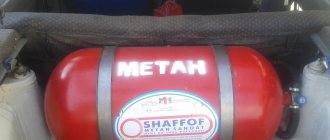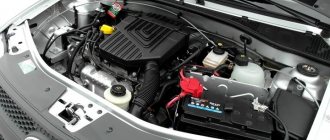The 1.8 engine Lada Vesta SV Cross is the heart of the domestic station wagon, which is one of the most important and significant parts. From this article you will learn absolutely everything about the 16-valve 1.8 Lada Vesta SV Cross engine with index 21179 - its strengths and weaknesses, characteristics, design, etc.
Let's start with a short excursion into history. About 5 years ago, a completely new 16-valve engine with index 21179 appeared on the AvtoVAZ conveyors. Outwardly it was similar to its predecessors, but inside it was very different from them.
Brief content of the entry
Engine problems 1.8 Lada Vesta SV Cross
Knocking of hydraulic compensators Increased oil consumption Broken timing belt Difficult access to some components during repairs
Does the 1.8 Lada Vesta SV Cross engine bend valves when the timing belt breaks?
Yes, the 1.8 Lada Vesta SV Cross engine bends the valve when the timing belt breaks.
What engine does the Lada Vesta 1.8 SV Cross have?
Under the hood of the Lada SV Cross 1.8 there is an engine 21179
Engine 1.8 Lada Vesta resource
The service life of the Lada Vesta 1.8 engine is about 200 thousand km.
Even earlier, in Togliatti there had already been attempts to assemble a 16-valve 1.8, but they were unsuccessful. Although the engine itself was assembled on the basis of the 21124 that was already available at that time, which today is considered one of the most successful VAZ engines. The previous 1.8 received the index 21128. But it never went into production due to an unsuccessful design, increased oil consumption and an extremely short service life. This engine barely reached 100 thousand kilometers and was already in need of major repairs.
The subsidiary produced small-scale Ladas with this engine, but only a few have survived to this day. In particular, 1.8 engines from Super-AUTO were in Lada Priora cars, but this modification never gained popularity, so production was curtailed, postponing 1.8 until better times.
What are the dangers of incorrect installation?
Incorrect installation of the timing belt leads to an imbalance of air intake and exhaust gases. When driving in these conditions, the driver may notice:
- loss of power;
- wear of all elements of the drive system;
- increased fuel consumption;
- the appearance of suspicious noises and vibrations.
If a discrepancy between the timing marks is detected or other signs of a timing discrepancy appear, the timing belt must be rearranged immediately. When correcting, you need to check the condition of the rubber and make sure there is no wear.
The integrity of the timing belt is a prerequisite for the functioning of the car. A torn part often causes bent valves, leading to major repairs.
Technical characteristics of the 1.8 Lada Vesta SV Cross engine
In the summary table we have collected the main declared characteristics of the 1.8 Lada Vesta SV Cross engine.
| Index | 21179 |
| engine's type | Petrol |
| Supply system | electronically controlled fuel injection |
| Volume | 1.8 L (1774 cc) |
| Maximum power | 90 kW (122 hp) / (at 5900 rpm) |
| Maximum torque | 170 Nm (at 3700 rpm) |
| Toxicity standard | Euro 5 |
| Recommended fuel | gasoline AI92 or AI95 |
| Average fuel consumption (with manual transmission): | |
| Urban cycle | 10.7 l/100 km |
| Country cycle | 6.4 l/100 km |
| Mixed cycle | 7.9 l/100 km |
| Fuel tank volume | 55 l |
| Maximum speed | 180 km/h |
| Acceleration time 0-100 km/h | 11.2 s |
In general, nothing surprising or outstanding, but at this stage this is all you need to know about the 1.8 Lada Vesta SV Cross engine.
How is the timing belt changed without the help of specialists?
It is worth thoroughly preparing for the operation. Ideally, an electro-hydraulic two-post lift of the P-3.2G type is suitable, but you can get by with an overpass or inspection hole. First of all, collect the necessary set of tools:
- Traverse.
- The key is "17".
- Hex wrench "5".
- Driver and set of Torx sockets.
- Set of sockets and open-end wrenches.
- Extension for wrench and set of slotted screwdrivers.
- Device 67.7811-9516 or 67.7811-9704 for fixing camshafts.
- Lock ring pliers or special wrench type 67.7812.9573-01.
Engine design Lada Vesta SV Cross 1.8 21179
Engine 21179 looks like this:
And this is what a real sample looks like:
The main difference between this engine and its predecessors is the presence of a variable valve timing system. In general, this is the first AvtoVAZ engine to be equipped with such a system. But to implement it, a large number of nodes had to be modified.
Let's start with the fact that this motor is controlled by an electronic throttle. Yes, the E-GAZ system is familiar to us from the latest VAZ 2114 and Lada Priora models. But she didn’t bypass Vesta either. And there was no other option - the motor must comply with Euro 5 environmental standards, which means it cannot be done without an electronic throttle.
Next comes a modified intake manifold made of heat-resistant plastic.
To increase the volume of the combustion chamber, the height of the rise and fall of the piston was changed, for which it was necessary to change the crankshaft and connecting rod-piston group. Thanks to all the manipulations, the piston stroke was increased from 75.6 to 84.0 mm. To compensate for friction losses due to the increased piston stroke, the diameters of the crankshaft connecting rod journals were reduced by 4.8 mm (from 47.8 to 43 mm). The crankshaft oil channels have also been changed, and a class mark for the main and connecting rod bearings is now applied to the ends of the CV for more accurate engine assembly.
The connecting rods are made using breaking technology - the lower head of the connecting rod is torn during assembly to more accurately connect the two halves. The connecting rod itself has been reduced in size from 133 to 128 mm, i.e. by 5 mm. AvtoVAZ does not produce connecting rods and piston groups, but purchases them from a third-party company, Federal Mogul. By the way, the pistons are now lightweight and have a graphite coating. The piston rings remain unchanged, except for the oil scraper ring, which is now coated with chrome.
The crankshaft and cylinder block are manufactured at the AvtoVAZ plant in Tolyatti. This is a purely VAZ development.
The most interesting thing, of course, is the timing system. To implement it, it was necessary to completely rework the cylinder head, making additional channels in it for supplying oil to the phase shifter, as well as making a mounting location for the valve and phase sensor. There is a master disk on the intake camshaft, which is used to read the engine speed.
By the way, the camshafts themselves are now hollow inside, which has made them significantly lighter, and they are made by the South Korean company Toyota Tsusho.
To implement this system, it was necessary to install a more efficient Korean GMB oil pump, which produces a capacity of 54–60 liters per minute versus 34–38 liters per minute for the VAZ, as well as modernized main bearings.
The valves are also foreign-made Mahle. They are lightweight to increase inertia and valve opening speed. Corresponding guides, crackers, springs and plates are made for these valves.
The intake camshaft has a phase angle adjustment mechanism. This is a standard design for DSV, but made specifically for the VAZ engine. The supplier is the German company INA, which is widely known in automotive circles and beyond. The timing belt is Continental, with a service life of 180 thousand km. However, I would not trust the manufacturer rather than wait until the end of the resource to replace it. It is better to do routine maintenance earlier than required than to overhaul the engine when it breaks.
What else? We partially mentioned the timing mechanism, but did not mention the rollers and pump. The support and tension rollers are also made by INA.
The tension roller has a new tension mechanism. The pump on this engine is a high-performance one from the Korean company GMB. It is driven by a timing belt.
The fuel rail is also from Continental with high-performance injectors.
Options and prices
Comfort
Lada Vesta SW Cross with a base engine in the standard Comfort configuration with 106 horsepower costs 906,000 rubles. The same variation with a 122 hp engine. valued at 930,000 rubles. The Comfort package will cost the most with a 113-horsepower engine and a CVT. The price of this combination is 991,000 rubles.
When purchasing a Lada Vesta SW Cross, the car will be supplied on 17-inch aluminum wheels. The optics are completely halogen, but front and rear fog lights are standard. Turn signal repeaters are built into the side mirrors. In addition, they are electrically heated and can be conveniently adjusted using a servo drive. Additional decorative elements in the exterior of the cross-station wagon include roof rails and a rear spoiler.
The salon has a combined upholstery as standard. In addition to the fact that the seats are electrically heated as standard, they have good lumbar support. Due to the fact that the driver's seat has a number of different adjustments, including height, as well as the ability to adjust the steering wheel not only by the angle of inclination, but also by reach, the driver will be able to choose the optimal position for himself for a comfortable and not tiring ride. At the same time, switching your favorite audio tracks from the multifunction steering wheel will ensure maximum safety and reduce unnecessary movements during the trip.
Despite the fact that full climate control is not available in this configuration, it boasts a pre-installed air conditioner, which is controlled from a unit located on the center console. In addition, the Comfort modification is equipped with a standard audio system, represented by a radio with support for radio, MP3, 4 speakers, USB, AUX and SD cards. Additional equipment of the Lada Vesta SW Cross includes a functional box in the trunk, as well as a curtain. There is a full-size spare wheel in a special niche in the luggage compartment. Electric windows are available not only to those sitting in the front of the Lada Vesta SW Cross. They are also in the back row.
Safety systems in the Comfort package include:
- frontal airbags;
- ISOFIX mount;
- ERA-GLONASS system;
- three-point seat belts;
- ABS;
- ESP;
- brake force distribution system;
- auxiliary braking system;
- turning on the hazard warning lights automatically during emergency braking;
- traction control system;
- hill start assist system;
- Cruise control;
- automatic door locking while driving;
- rear parking sensor.
Luxe
Prices for the Luxe package start from 959,000 rubles and reach their peak at around 1.107 million rubles. The fact is that this modification is offered with various optional packages. But as standard, its main differences from the Comfort version are the presence of rain and light sensors. Moreover, instead of 4 headrests, there are already 5 in the cabin. In addition to the side airbag, the safety systems are supplemented with the “walk me home” function, as well as dynamic cornering lighting.
Instead of an air conditioner, this configuration has a full-fledged climate control system, and additional lighting comes on when entering the cabin. By paying 44,000 rubles, the buyer activates the Multimedia package. In addition to the 7-inch touchscreen multimedia system with a rear camera, it also includes a leather-wrapped steering wheel and an electrically heated steering wheel. In addition, the version with a CVT in the Luxe configuration is also equipped with a special Prestige package. It includes LED ambient lighting, as well as heated first-row seats and a rear dividing armrest.
Transmission, brakes and suspension characteristics
| Drive unit | Rear drive |
| Number of gears (manual gearbox) | 5 |
| Front suspension | Independent, McPherson spring, with stabilizer |
| Rear suspension | Semi-independent, coil spring |
| Front brakes | Disk |
| Rear brakes | Disk |
| ABS | Yes |
| Steering type | Steering rack |
| Power steering | Electric booster |
Engine problems 1.8 Lada Vesta SV Cross
The design of the 1.8 Lada Vesta SV Cross engine provides high power, fuel efficiency and a long service life with proper maintenance. However, it was not without problems. The main ones are:
1. Knock of hydraulic compensators . This is not the most serious problem, but it occurs on the 16-valve 1.8 21179. In most cases, the reason for the knocking of hydraulic compensators in the Lada Vesta SV Cross is the incorrectly selected engine oil. It is enough just to change the oil in the engine to a new one, the hydraulic compensators will be pumped and will stop making noise. If this procedure does not help, then more serious repairs will be required - either replacing the hydraulic compensators with new ones (if they are the problem) or checking the oil pressure in the entire system with subsequent repairs.
2. Increased oil consumption. No matter how reliable and simple this engine is, according to AvtoVAZ, it is not spared the problem of oil consumption. Due to the large number of warranty claims from customers, dealers took measurements, sealed the engine, and if oil consumption exceeded the permissible 700 ml, the engine was sent for repair or replaced with a new one.
The engine life is on average 220,000 km, and with proper maintenance it can last 400 thousand. But, if you’re lucky... And the oil-guzzler will bypass it. The reason for the increased oil consumption lies in the piston group, due to which the cylinder walls are broken when the piston is repositioned, which causes engine oil to leak into the combustion chamber and increased oil consumption.
3. Broken timing belt. Although the factory stated that the timing belt runs for all of its 180 thousand km, it is not uncommon for the belt to break long before this mileage. Because of this, the owner ends up with expensive repairs.
4. Difficult access to some components during repairs. Yes, almost all modern cars suffer from this problem and the 1.8 Lada Vesta SV Cross engine is no exception. For example, replacing a timing belt or pump yourself will require the owner to have special tools and a lot of time to get to these parts.
Otherwise, the engine showed itself only on the good side. It is quite “nimble” for its volume, economical, does not cause major problems for the owner, and its maintenance will not put a price on your pocket.
No increase in agility
It’s a paradox, but the rear of the body in the Vesta is better soundproofed than in the Solaris. He has bare metal around the spare tire, and in the VAZ station wagon there are mats glued on here, albeit made of batting, the reserves of which, it seems, have not dried up at the Tolyatti plant since Soviet times. Nevertheless, they exist, and this is reflected: on the move, the Vesta is quieter than the Solaris, although, perhaps, this difference can be attributed to the incredibly noisy tires with low rolling resistance, which the test sedan was shod with .
But it has the advantage of a faster engine. With the same displacement, it produces a dozen more horses, and all of them are easy to climb. And we have Vesta with a new unit - Nissan's, with 113 horsepower, the same one that is familiar to many from the Qashqai, Almera and Juke models. The character of this unit is dual.
On the one hand, in urban conditions, Vesta pleases with its dynamics. In dense traffic on the streets and avenues, it seems quite “alive”, at least not inferior to its numerous competitors. It’s a different matter on the highway - where does the speed go? Actually, nowhere, you just have to “spur” our station wagon and it will respond. That is, at 2000-2500 rpm we just roll, and at 3000 we finally begin to accelerate, but it’s better to reach 4000 rpm, that is, the passport level of maximum torque. It is clear that this takes time, seconds and seconds. 2-3 with Vesta will definitely lose to Solaris in acceleration from 80 to 120 km/h.
I check with a stopwatch: in this range, the VAZ station wagon accelerates in automatic mode in about 10 seconds. Maybe manual gear selection will help the dynamics? Not much. I choose the fourth “stage” - the result is the same, up to tenths of a second. On the third I improve it extremely slightly - by 0.3-04 s. At the same time, by 120 km/h the tachometer needle almost reaches the red rev zone. At the fifth and sixth stages I don’t even check the dynamics, although, judging by the city mode, the fifth “level” of Vesta is more efficient than that of Solaris.
Perhaps the delay is caused by the new transmission? After all, with a Nissan engine we get a Japanese JATCO variator. Alas, buyers of VAZ cars, dissatisfied with the “robot” AMT, did not wait for the automatic machine. Will the CVT please them? After all, a priori there are complaints about him.
Firstly, according to statistics from independent car services, its service life is about 150-170 thousand kilometers. Then, inevitably, serious repairs follow, which can be brought about by a “ragged” rhythm of movement with sharp accelerations and braking. Secondly, for normal service during this period, you should not only not neglect regular maintenance, but also use special oil in the device.
By the way, about the “contents” of the variator. Vesta’s on-board computer does not measure the temperature inside it, but it would be nice to do so. However, the breather, which on the test car was mounted on a flexible hose upward relative to the gearbox housing, protects against its excessive increase. But as it was removed, it was fixed in the holder so weakly that it fell out during movement... The unit is shown in the photo. If the factory workers have not done this, the simplest solution suggests itself: tighten the head of the breather to the holder with a plastic cable tie.
It’s such negligence that spoils the impression of a quite nice and practical car. Moreover, they are raised, as they say, onto a shield and presented as fatal flaws. They blame the Togliatti factory workers, who supposedly inherited the “best traditions” of Soviet assembly, and even the place on which the Volzhsky Automobile Plant was built. In my opinion, there is absolutely nothing criminal in such little things, and my personal impression of the “Vest” with the SW index, on the contrary, consists of positive aspects, for example, the organization of the same trunk. And fixing the breather yourself, in my opinion, is simply interesting. Well, those who wish can complain about a “defect” by contacting the dealership, and they will probably fix it under warranty. My three-year experience of owning an Xray suggests that VAZ is now okay with this.
Does the 1.8 Lada Vesta SV Cross engine bend valves when the timing belt breaks?
Yes, the 1.8 Lada Vesta SV Cross engine bends the valve when the timing belt breaks. This is not a significant disadvantage, since most modern cars are designed in a similar way. It's all about the compression ratio, thanks to which the efficiency of the motor is achieved. If you “unclench” the engine, it will not be as responsive to the gas pedal, and the car will drive much worse.
Therefore, if the timing belt breaks, the water pump or one of the rollers jams, a major repair is guaranteed. But it is not all that bad. It is necessary to change the timing belt and rollers in a timely manner, as well as choose high-quality parts in order to avoid tragic consequences.
Cost of timing belt repair kit
An original repair kit for a 16-valve Vesta engine costs from 3,000 rubles. The price of analogues takes the value of 2900-3700 rubles. Separately, the original timing belt (article 21126100604000) will cost 1,700 rubles. AvtoVAZ offers a reinforced version for 1900 rubles.
Along with the parts of the gas distribution mechanism, owners of the 16-valve Vesta often change the water pump. It is recommended to change the pump every 100 thousand kilometers, so installing a new pump is combined with replacing the timing drive element. A pump with the AvtoVAZ logo (artikul 21126130701082) costs 1,100 rubles, Luzar (LWP 01274) - from 950 rubles, Pilenga - 650 rubles.
Lada Vesta SV engine 1.8 reviews
At the beginning of 2022, I became the owner of a Lada Vesta SV CROSS with a 1.8 liter engine. At the moment, the mileage is 35 thousand km and there are no problems with the engine. It drives decently, stays in line, and doesn't burn oil. In the city this engine is enough. Fuel consumption with my driving style is 10-12 liters in the city and 8-9 on the highway. I think that this is a successful engine from AvtoVAZ. Although, in my case, it’s too early to draw conclusions. If this engine goes up to 100 thousand km without breakdowns, then everything is fine with it!
Dmitriy,
Kazan
This year I bought a used Lada Vesta with a 1.8 liter engine 16 valves 21179. The first thing I encountered was the clatter of hydraulic compensators on a cold car. Especially in winter. For a few seconds after starting, the engine made a loud clicking sound, probably with half of its hydraulics. After 5-10 seconds they gradually subsided. And they didn't cause any more problems. With the onset of heat, the hydraulics began to knock even on a hot engine. The problem was partially solved by switching to Shell Helix HX8 5W40 oil. I'm still watching, but I don't want to do expensive repairs.
Alexei,
Yurga
The worst thing I encountered with this engine was a broken timing belt. Although the mileage is very low for replacement - only 70 thousand km. The plan was to change the belt at 100 thousand, but I didn’t get there. The capital amounted to 50 thousand with spare parts and labor. I can't call this engine reliable, but it drives very well. It starts off great from a traffic light and easily passes all sorts of foreign cars up to two liters. To take it or not to take it - decide for yourself.
Anton,
Perm
Why did it happen so?
Perhaps the automatic requests do not belong to you, but to another user accessing the network from the same IP address as you. You need to enter the characters into the form once, after which we will remember you and be able to distinguish you from other users exiting from this IP. In this case, the page with the captcha will not bother you for quite a long time.
You may have add-ons installed in your browser that can make automatic search requests. In this case, we recommend that you disable them.
It is also possible that your computer is infected with a virus program that is using it to collect information. Maybe you should check your system for viruses.
If you have any problems or would like our support team, please use the feedback form.
For many years, domestic cars have been popular due to their availability - the VAZ is inexpensive, and the cost of repairs is not prohibitive. The situation became a little more complicated after the release of Priora and Kalina, but even here our motorists did not fall face down in the mud. We are gradually gaining experience in repair work on the Lada Vesta, although, admittedly, this is becoming more and more difficult to do.
What engine does the Lada Vesta 1.8 SV Cross have?
Many people ask this question, but in reality everything is simple. Under the hood of the Lada SV Cross 1.8 there is an engine 21179. This is not a fundamentally new engine, but a modified 1.6 21129. But for the modified version there is a lot of new stuff in it. This is a 16-valve unit with distributed fuel injection, electronic control and a variable valve timing system.
Competitors
Possessing decent equipment and an affordable price, the Russian cross-station wagon does not have many competitors. However, various ratings on Internet resources include the main rivals of the Lada Vesta SW Cross:
- Renault Sandero Stepway;
- Ford Focus;
- Kia Rio X-Line;
- Skoda Rapid Spaceback.
Engine 1.8 Lada Vesta resource
The service life of the Lada Vesta 1.8 engine is about 200 thousand km. He is very far from becoming a millionaire, and no one makes such engines now because of the economic component.
However, it all depends on many factors, the most important of which is your attitude towards the car and your driving style. If you maintain this engine in a timely manner and use high-quality consumables in the form of oil and filters, and also do not constantly turn up the speed to the red zone, then this engine can cover the entire 400 thousand km.
Features of the VAZ-21129 power unit
The internal combustion engine works with both a manual transmission and an automatic transmission. Engines 21129 were transformed from a weaker version of the VAZ-21127, which did not meet Euro-5 standards. This transition turned out to be very useful for the overall automotive industry of the country. The following reformation of the engine design should have been made:
- The new product, unlike 21127, has a reduced compression ratio. From now on, it is possible to fill with fuel with a lower octane number.
- The exhaust and resonant intake systems have been completely redesigned.
- The electronic engine control system (ECM) has received completely new firmware.
- The engine suspension was significantly adjusted.











